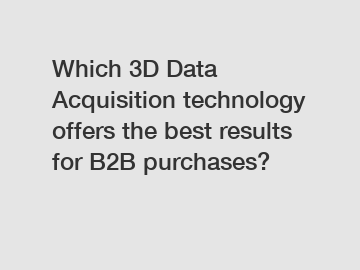Which 3D Data Acquisition technology offers the best results for B2B purchases?
When it comes to B2B purchases, selecting the right 3D data acquisition technology can make a world of difference in the quality of the results. With various options available in the market, it can be challenging to determine which technology offers the best results for B2B purchases. In this blog post, we will explore three of the top 3D data acquisition technologies and discuss their strengths and weaknesses to help businesses make an informed decision.
1. LiDAR Technology:
LiDAR (Light Detection and Ranging) technology is a popular choice for 3D data acquisition due to its high precision and accuracy. This technology uses laser pulses to measure distances and create detailed 3D models of objects and environments. LiDAR is commonly used in industries such as construction, agriculture, and archaeology for applications like mapping, surveying, and monitoring.

One of the key advantages of LiDAR technology is its ability to capture high-resolution data with sub-centimeter accuracy. This makes it ideal for applications that require precise measurements and detailed visualization. LiDAR is also known for its fast data acquisition speed, making it a valuable tool for time-sensitive projects.
However, LiDAR technology can be expensive and complex to implement, requiring specialized equipment and trained personnel. Additionally, LiDAR data can be affected by environmental factors such as weather conditions and surface reflectivity, which may impact the quality of the results. Despite these challenges, LiDAR technology remains a top choice for businesses that prioritize accuracy and precision in their 3D data acquisition needs.
2. Photogrammetry Technology:
Photogrammetry is another popular 3D data acquisition technology that uses photographs to create 3D models of objects and environments. This technology works by analyzing the geometry and texture of images to reconstruct 3D structures digitally. Photogrammetry is widely used in industries such as architecture, engineering, and gaming for applications like modeling, visualization, and simulation.
One of the main advantages of photogrammetry technology is its accessibility and affordability. With advancements in digital cameras and software, businesses can easily capture high-quality images and process them into 3D models. Photogrammetry also offers flexibility in terms of data acquisition methods, allowing users to capture images from various angles and distances.
However, photogrammetry technology may have limitations in terms of accuracy and resolution compared to LiDAR technology. The quality of the results can be affected by factors such as camera resolution, lighting conditions, and image distortion. Despite these challenges, photogrammetry technology is a cost-effective solution for businesses that require 3D data acquisition for visualization and design purposes.
3. Structured Light Scanning Technology:
Structured light scanning technology is a 3D data acquisition method that uses patterns of light to capture surface geometry and texture. This technology projects a series of light patterns onto objects and analyzes the distortion of these patterns to create 3D models. Structured light scanning is commonly used in industries such as manufacturing, automotive, and healthcare for applications like quality control, reverse engineering, and medical imaging.
One of the main advantages of structured light scanning technology is its speed and efficiency. This technology can capture detailed 3D data quickly and accurately, making it ideal for high-volume scanning projects. Structured light scanning is also non-contact, which eliminates the risk of damaging delicate or sensitive objects during data acquisition.
However, structured light scanning technology may have limitations in terms of range and depth of field compared to LiDAR technology. The accuracy of the results can be affected by factors such as surface texture, reflectivity, and ambient lighting conditions. Despite these challenges, structured light scanning technology offers a practical solution for businesses that require fast and precise 3D data acquisition for industrial and commercial applications.
In conclusion, selecting the right 3D data acquisition technology for B2B purchases depends on various factors such as accuracy, speed, cost, and application requirements. While LiDAR technology excels in precision and detail, photogrammetry technology offers accessibility and affordability, and structured light scanning technology provides speed and efficiency. By understanding the strengths and weaknesses of these top 3D data acquisition technologies, businesses can make an informed decision to meet their specific needs and achieve the best results for their B2B purchases.
Are you interested in learning more about What Is Geophone, 3D Seismic Exploration, 2d Seismic Data Acquisition? Contact us today to secure an expert consultation!

Comments
0